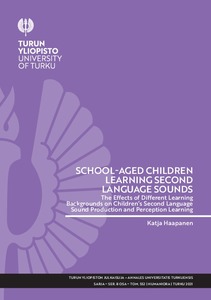Artificial Grammar Learning in Finnish Pre-school-aged Children with and without Developmental Language Disorder. The Helsinki Longitudinal SLI Study
Weurlander, Tarja (2020-06-18)
Artificial Grammar Learning in Finnish Pre-school-aged Children with and without Developmental Language Disorder. The Helsinki Longitudinal SLI Study
Weurlander, Tarja
(18.06.2020)
Julkaisu on tekijänoikeussäännösten alainen. Teosta voi lukea ja tulostaa henkilökohtaista käyttöä varten. Käyttö kaupallisiin tarkoituksiin on kielletty.
suljettu
Julkaisun pysyvä osoite on:
https://urn.fi/URN:NBN:fi-fe2020091669648
https://urn.fi/URN:NBN:fi-fe2020091669648
Tiivistelmä
Children with Developmental Language Disorder (DLD, previously more commonly known as Specific Language Impairment, SLI) have been found to show deficits in domain-general statistical learning abilities compared to their typically developing (TD) peers and consequently find it more difficult to learn both linguistic and non-linguistic sequences. Increased understanding of the types of sequence learning that pose particular challenges for children with DLD as well as the potential role of bilingualism in the extent of such challenges would be valuable for diagnostic and potentially also for remedial purposes. This study therefore focused on investigating differences between monolingual and bilingual children with DLD and their TD peers in the ability to learn different types of non-linguistic sequences in the visual and auditory modality. No previous studies of a similar magnitude and complexity are known to exist on this topic.
136 pre-school-aged children with DLD and 134 TD peers completed one of three different computer-based Artificial Grammar Learning (AGL) tasks designed for the Helsinki Longitudinal SLI Study (HelSLI) in two modalities. Visual and auditory sequence learning were separately compared between children with DLD and their TD peers using ANCOVAs (with age as a covariate) with language status (monolingual, bilingual) and sequence learning task type (adjacent dependency learning, non-adjacent dependency learning, exemplar-based learning) as the other two between-subjects factors. Moreover, separate one sample t-tests were conducted for each group (DLD, TD) x language status (monolingual, bilingual) subgroup to compare learning to chance level in each task type.
No main effects of group or language were found in children’s visual sequence learning performance. A significant main effect of task type and its interaction with group, however, as well as an interaction between group and language status were found in the visual modality. Non-adjacent dependencies were found significantly easier to learn than adjacent dependencies. TD children performed relatively evenly across all three task types, whereas children with DLD performed better in non-adjacent dependency learning than in the other two tasks. Monolinguals outperformed bilinguals in visual sequence learning among children with DLD, while the opposite was the case for TD children. Monolingual children with DLD were the only subgroup to show above-chance level visual sequence learning, namely of non-adjacent dependencies. None of the analyses regarding auditory sequence learning performance yielded significant results. The results of this study were inconclusive in several respects and some adjustments to stimuli and task design were consequently suggested to help make sequence learning easier in future task versions.
136 pre-school-aged children with DLD and 134 TD peers completed one of three different computer-based Artificial Grammar Learning (AGL) tasks designed for the Helsinki Longitudinal SLI Study (HelSLI) in two modalities. Visual and auditory sequence learning were separately compared between children with DLD and their TD peers using ANCOVAs (with age as a covariate) with language status (monolingual, bilingual) and sequence learning task type (adjacent dependency learning, non-adjacent dependency learning, exemplar-based learning) as the other two between-subjects factors. Moreover, separate one sample t-tests were conducted for each group (DLD, TD) x language status (monolingual, bilingual) subgroup to compare learning to chance level in each task type.
No main effects of group or language were found in children’s visual sequence learning performance. A significant main effect of task type and its interaction with group, however, as well as an interaction between group and language status were found in the visual modality. Non-adjacent dependencies were found significantly easier to learn than adjacent dependencies. TD children performed relatively evenly across all three task types, whereas children with DLD performed better in non-adjacent dependency learning than in the other two tasks. Monolinguals outperformed bilinguals in visual sequence learning among children with DLD, while the opposite was the case for TD children. Monolingual children with DLD were the only subgroup to show above-chance level visual sequence learning, namely of non-adjacent dependencies. None of the analyses regarding auditory sequence learning performance yielded significant results. The results of this study were inconclusive in several respects and some adjustments to stimuli and task design were consequently suggested to help make sequence learning easier in future task versions.
Samankaltainen aineisto
Näytetään aineisto, joilla on samankaltaisia nimekkeitä, tekijöitä tai asiasanoja.
-
eLearning provides added value to training services and for the eLearning consumers – or does it? : A Case study about different perceptions and attitudes towards eLearning
Tuomilehto, Kaisa (27.11.2019)Nowadays employee training is more important than before, and knowledge work has become more significate for corporations during the last decade. More and more corporations have started to invest in digital training, and ...suljettu -
Motivation for learning Korean in Finland : Why do people learn Korean, and how do people maintain motivation for learning Korean in Finland?
Choi, Boreumi (19.06.2024)In recent years, there has been a surge of global interest in learning Korean as a foreign language. The reasons for learning Korean are varied, including opportunities for study, employment, personal enrichment, communication, ...suljettu -
School-aged children learning second language sounds: The Effects of different learning backgrounds on children’s second language sound production and perception learning
Haapanen, Katja
Turun yliopiston julkaisuja - Annales Universitatis Turkuensis, Ser B: Humaniora : 552 (Turun yliopisto, 29.10.2021)Earlier phonetic research on children’s second language sound learning has primarily focused on naturalistic language learning environments and the comparison of child and adult learners. The aim of this thesis was to ...
